Gunboat diplomacy
The story of the Royal Navy is forever linked to its high seas grand fleet at Scapa Flow, but behind, the Empire depended on a myriad of smaller, less glamorous vessels: The Gunboats. Slower, less protected and less armed with everything afloat, they looked at first glance weak, but in reality played their part in history: The British Empire invented “gunboat diplomacy”, depending on these unassuming small ships mostly for “police duties” in far distant, mostly tropical waters. Dubbed at times the “poor’s cruisers”, owned by navies that can hardly afford larger vessels, they had relatively large guns depending on the type and can perform a large variety of mission, less battlefleet duties. They traded their weakness for riverine capabilities, flexibility and good armament. This story is a long one, so sit back and relax, for we have a go into the British gunboats saga today over a century, from Crimea to WW2.
History and roles of gunboats
Historically it is hard to pinpoint the exact birth of the concept. During the age of sail, any small ship, undecked, carrying a single smoothbore cannon in the bow, or just 2-3 of them, could be considered as such. It is often close to another concept of the age of sail, the Galiot, a type of modified decked corvette-size vessel armed with a single, very large mortar buried in its deck, and small defensive guns. These were siege vessels, but the gunboat was more of a defensive ship, as single-masted and about 15 m (49 ft) in length. It was much larger than a rowing boat, and perhaps inspired by the latter. It was not rare in the XVII-XVIIIth centuries that landing parties called for rowing boats assaulting a beach with a serpentine, 6-pounders (3.5in) or demi-cannon, installed on an improvized mattress to absorb the recoil. Ideally it would fire only once, at short range, a lead ball or shrapnell.
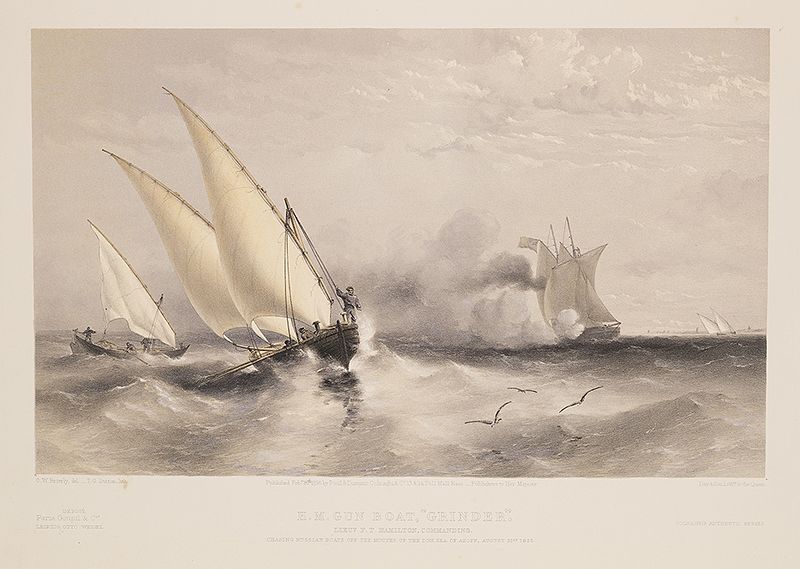
The gunvessel Grinder chasing Russian boats in the Sea of Azov, 31 August 1855
Larger gunboats in addition to their main, large gun, often had swivel guns for defence. In the baltic for example, Frederick af Chapman pioneered two types of shallow-draft gunboats ideal as a complement to his hybrids polacca to fight Russian galleys: These were the 20 m (66 ft) “gun sloop” (‘kanonslup’) armed with two 24-pounders, stern and bow, or the 15 m “gun yawl” (‘kanonjolle’) with a single bow 24-pounder. Perhaps to answer the Russian Skampayevas. Most Russian galleys of the time, like their Mediterranean counterparts were also only armed with a few guns (three generally) in the bow only. This led to a fight in line, with prows facing each others. In between islands, they were a good defensive measure. Their legacy went on as Napoleon built many for his planned invasion of England in 1804 and during the early days of the USA, Jefferson planned a fleet of gunboats to defend its harbours.
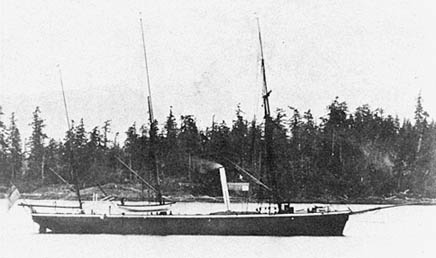
HMS Forward (1855-1870)
During the age of sail, gunboats were among the first ships to invest in steam as well as the last to drop sails as a way to spare their precious coal supply. It was not long in 1830 before dispatch vessels adopted it (basically couriers for much larger man-o-war), later also called “aviso” or “sloop”. Before steam was adopted for larger ships, gunboats soon received a mixed propulsion. They had paddle wheels, which the admiralty did not wanted on its larger ships for obvious reasons, until the screw propeller arrived and imposed itself. Gunboats would have occasion to fight, like the wooden paddle-gunboats used on the Lower Great Lakes and St. Lawrence River (1837 Canada rebellion). The USN deployed also a single one on the Great Lakes in 1844 (USS Michigan). In 1849 Germany was not united yet, and the small navy of Schleswig-Holstein ordered the 120 tonnes iron-hulled “Gunboat No. 1” (SMS Von der Tann) which played a decisive part in First Schleswig War of 1848–1851. But the “gunboat craze” really commenced for UK at the occasion of the Crimean war. The government planned a massive construction program, delivering scores of such ships. To know more about them, check the Royal Navy in 1870.
Early British gunboats (1850-1870)
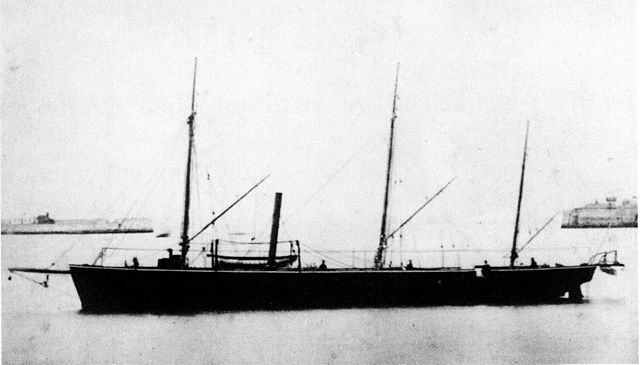
HMS Raven, of the Albacore class (1856)
The first were the six Arrow-class, armed with two 68-pdr Lancaster MLRs. This really was mass-production, well beyond any other type in service in 1870. In total, the Crimean war needs spawned nine class: The Albacore 1855-56, 232 tonnes, two 68-pdr, 96 built, but not to last. not built to last. 30% were still active in 1870 and most ended discarded until 1884. Other classes included the Intrepid, Vigilant, Gleaner, Dapper, Albacore, Cheerful, Clown and Algerine classes, five Paddle gunboats, three 16-gun, two 12-guns sailing brigs, all in 1870.
They were followed by the first British Armoured gunboats: the Vixen class (1865). 1230/1280 tonnes, fitted with 4-1/2 inch armour plating backed by 10-inches wood, armed with two 7-in guns (254 mm), two 20-pdr guns,. These “pocket ironclads” comprised the Vixen, Viper and Waterwitch completed in 1866-67. The first two constituted the local fleet of Bermuda for the whole of their career.
But soon, the RN embarked in the construction of additional Wooden masted gunboats for other colonial stations:
The Philomel (1859), Cormorant (1860), Plover (1862) and Britomard classes (1867). Less cheap but larger and sturdier, the Composite masted gunboats followed the recipe for the masted cruiser. They mixed an iron frame and keel with a wooden skin and parts. Best example was the Beacon class (1867).
Shortly before 1870, additional Flatiron gunboats were also built, the HMS Staunch (1867), Plucky (1870) and and the Ant, Gadfly, bouncer and Medina classes. In 1870 also was launch a very peculiar vessel, classed as a gunboat, but in fact, initiator of the torpedo gunboat” type: The HMS Vesuvius. Even more outlandish was also launched the HMS Polyphemus, for her part a “torpedo ram”, and since both were armed with ‘torpedoes’ (explosives on spurs), they were classed as torpedo boats later.
British wooden gunboats were spread within British colonies, and in addition to Crimea where they were used to spare more precious ships of the line or Frigates, to bombard shore fortifications, they were also seen in action in the Second Opium War (1856–1860) and the Indian Mutiny (1857–1859). The type was in the 1870s split between very different types of vessels, from river gunboats, and river monitors to coastal-defense gunboats or even monitors mostly used for coastal bombardments.
The Rendel gunboats:
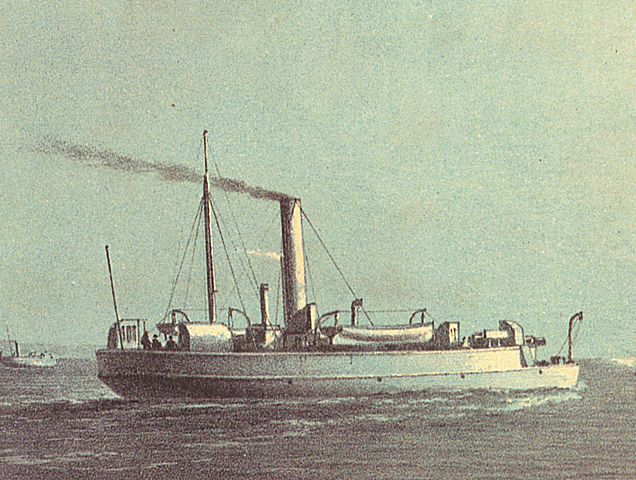
HMS Comet of the Ant class. The name was resurrected in WWI.
Also called “flatiron gunboats” these the invasion scare of the late 1860s-1870s produced a renewed emphasis on inshore warfare and the British government ordered a serie of small iron mastless gunboats in response to parliamentary pressure for improved coastal defense. Slow and unseaworthy, these thirty ships laid down in 1867-81 were nonetheless pressed into service in major British rivers, especially the Thames and Severn. Rendel was at the time Armstrong’s lead naval architect, which produced similar ships for foreign navies. The Ant and Gadfly classes and larger Bouncer class all had one 10-in MLR, quite a deterrent for any fleet. One of these in particular was very strange to a seaman eyes, HMS Medina, which was rigged as a fully three-masted vessel, even though she was intended for point defense are rarely move from her anchorage. A single of their three 64 pdr was mounted on a fixed bearing forward and had a pronounced tumble home, short poop and forecastle. All had bow rudders and some of these flatirons were used in China, on the Yangtse. Most ended their career as gunnery tenders, some still around in 1914.
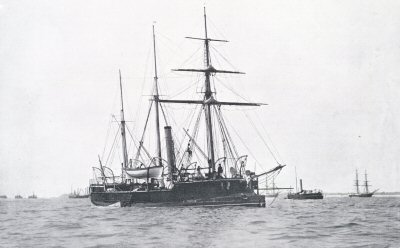
HMS Medina
Fisher’s reforms
Admiral Fisher’s reforms in the 1900s saw the old gunboat fleet discarded, and a few remaining vessels surd in harbor service. The last in active service of the Bramble class (ii) were active until 1926, based in west Africa’s rivers. The circumstances of World War I saw the Royal Navy replenishing a serie of small 625-long-ton (635 t), shallow-draught gunboats. These 12 vessels of the Insect-class were all intended for riverine warfare, with just a sufficient speed for fast-flowing rivers and relatively heavy armament to support ground operation and deal with any threat. They were deployed in Romania on the Danube and in Mesopotamia (Euphrates and Tigris) as well as in northern Russia (Northern Dvina) and of course on the Yangtze, in China. Far from the epics of the Grand Fleet, they protected British interests also during the interwar and until World War II. Larger, more modern gunboats were built in the late 1930s mostly for the Far East or were assembled in sections at Shanghai.
Nomenclature
Lest’s Recalls some acronyms here:
VTE: Vertical Tubes Engines
ihp: Indicated Horsepower
shp: Shaft Horsepower
bhp: Brute horsepower
pdr: Pounder
MLR: Muzzle Rifled loader (gun)
BL: Breech Loading (gun)
Masted Composite Gunboats (1880-89)
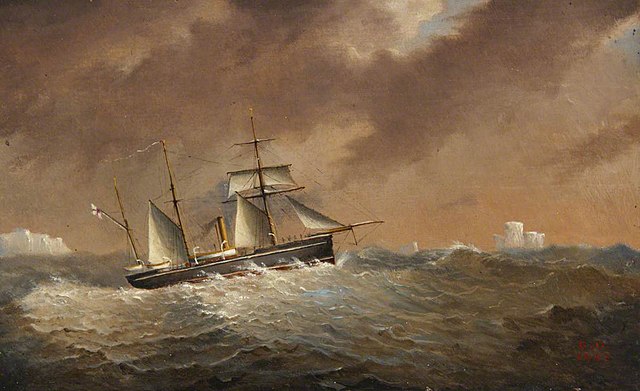
These were the oldest gunboats in service with the Royal Navy, maintained in various colonial locations around the Empire until 1905-1906. Indeed when in office, Admiral Jackie decided these were a source of cost for dubious military value and immobilisation of manpower much needed in the new destroyers fleets he planned. He only spared the most recent steel gunboats of 1898, posting instead after 1906 old pre-dreadnoughts and third class cruisers. With just four gunboats our story was likely to end there, but the ships themselves dating back to 1890 for the most recent ones, were still in good condition for various duties. Most in 1914 of those not scrapped have been reduced to harbor service or training, of a total of 26 still extant and spread among five classes. “Composite” meant they were built mostly in wood, but braced by iron framing, and some steel for the last ones: They had indeed an iron keel, frames, stem and stern posts, while the hull was planked with timber. Thanks to their wooden hull they could be coppered, keeping marine growth under control, especially under tropical climates. Due to limited anti-fooling chemistry at the time, iron hulled ships were often in drydock for scrapping their hull.
Banterer class (1880):
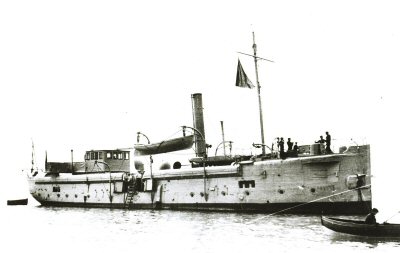
HMS Raven as a divers tender in WWI.
Initially 10 gunboats launched between 1880 and 1882. 560 tonnes, 31.10 x 7.16 x 3 m, 1 shaft reciprocating 440 ihp 9,5 knots.
They were armed originally with two 64 pdr MLR and two 20-pdr BL.
The class originally comprised Redwing, Grappler, Wrangler (Boom defence vessel from 1903, sold 1919), Wasp (Wrecked off Ireland 1884), Banterer, Espoir, Bullfrog (Hulk 1905, “Egmont” 1923, St Angelo 1933), Cockchafer, Starling (tug 1905 as Stella Maris, sunk by Halifax Explosion 1917), Stork (boys training ship 1893, BU 1950), Raven (training ship 1913, Sold 1925).
Albacore class (1883)
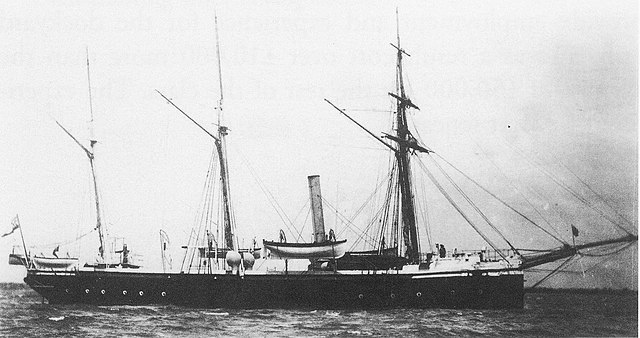
The Albacore class was designed by Nathaniel Barnaby, Admiralty Director of Naval Construction. They were a slightly larger version of the Forester and Banterer classes that preceded them. They pioneered the use of modern breech-loading guns as the main armament, but were the last gunboats to mount their weapons on traversing mountings.[1]
560 tonnes, 41.15 x 7.92 x 2.13-3 m, 2-cyl. compound-expansion steam engines from Laird Brothers of Birkenhead for 650 ihp, single screw, 10.7 knots (19.8 kph). She was armed with just two 5-inch/50-pdr (38cwt) breech-loading (BL) guns, two 4-inch/20-pdr breech-loading guns (BL) and two machine guns. All three were sold in 1905-1907.
Bramble(i) class (1886)
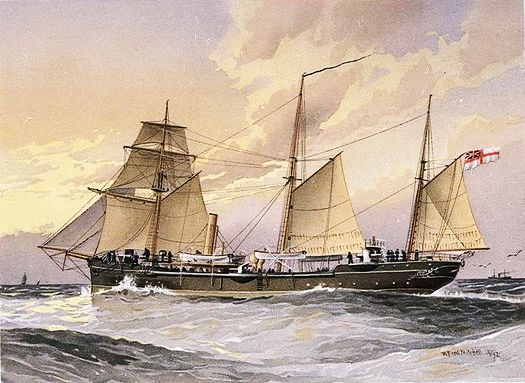
715 tons standard 50 x 8.8 x 3.4 m (165 x29 x 11 ft). TE engine, single screw, 1,000/1200 ihp, 10 knots (19 km/h), Range 2,500 nmi (4,600 km).
With their crew of 60 they were armed originally with six 4-inch/25-pdr QF and four MGs.
HMS Rattler was the only survivor of the class. It was reduced to Harbour service in 1910 and navigation school ship in September 1919 as HMS Dryad, sold 1924. HMS Wasp foundered after leaving Singapore in 1887. The other two were sold in 1905-1906
Pigmy class (1888)
The class comprised six vessel, mostly out of action in WW1. HMS Pigmy (sold 1906), Pheasant (sold 1906), Partridge (Sold 1909), Peacock (Sold 1906), Pigeon (Sold 1906), Plover (active WWI, sold 1927). Slightly larger vessels than the Bramble(i) at 755 tonnes standard (circa 820 FL), barquentine-rigged, same lenght but beamier at 9.14 and with a draught of 3.43 m, they carried the same usual six 4-in guns, one fore, one aft on the forecastle and poop, two either side in sponsons. Same crew of 76. All were sold between 1905 and 1912 but HMS Plover, still active in 1914 in harbor duties (status unknown). She was sold in 1924.
Redbreast class (1889)
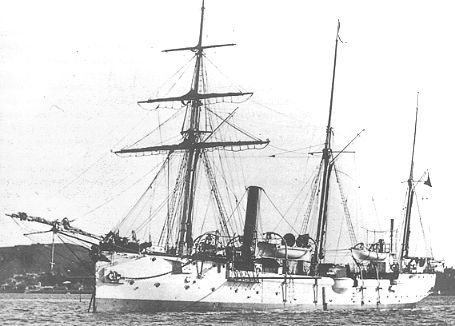
These were the last barquentine composite gunboats of the Royal Navy. Slightly larger, they added two 3-pdr to their armament.
805 tons, 50.3 x 9.4 x 3.35/4.19 m (165 x 31 x 11 ft). Powerplant, TE, 2 boilers, one screw prop 1,200 ihp (890 kW), 13 kn. Range: 2,500 nmi (4,600 km) at 10 kn.
With a complement of 76, they were armed for some with six BL 4-inch (101.6 mm) 25-pounder guns and four machine guns or same, but in addition two 3-pounder QF guns and two MGs.
HMS Magpie became a boom defence vessel in 1902, back to Gunboat in 1915, and depot ship in October 1915, sold 1921. Ringdove became a salvage vessel on 7 December 1915 as “Melita”, sold 1920.
Thrush became a coastguard in 1906, cable ship in 1915 and salvage vessel in 1916. Wrecked off Glenarm in 1917. Sparrow was transferred to New Zealand as a training ship on 10 July 1906 renamed “Amokura”. Sold as a coal hulk in 1922, BU 1955.
Read More/Src on WW1 British Gunboats
Gardiner, Robert; Gray, Randal, eds. (1985). Conway’s All the World’s Fighting Ships: 1906–1921
“Thistle”, Journal of the American Society of Naval Engineers, 11 (1899)
U.S. Office of Naval Intelligence, Notes on Naval Progress, November 1899, ONI
U.S. Office of Naval Intelligence, Notes on Naval Progress, July 1900, ONI
T.A. Brassey, ed. The Naval Annual, 1902 (Portsmouth, 1902)
Sir Philip Watts with J.H. Narbeth, “Ship”, Encyclopædia Britannica
Antony Preston and John Major, Send a Gunboat: The Victorian Navy And Supremacy At Sea, 1854–1904
Log books of HMS Bramble, Britomart, Dwarf, Thistle
Colledge, J. J.; Warlow, Ben (2006). Ships of the Royal Navy: The Complete Record of all Fighting Ships of the Royal Navy, Chatham Publishing.
Winfield, R.; Lyon, D. (2004). The Sail and Steam Navy List: All the Ships of the Royal Navy 1815–1889. London: Chatham Publishing.
https://collections.rmg.co.uk/collections/objects/67390.html
https://www.sas1946.com/main/index.php?topic=15679.0
https://collections.rmg.co.uk/collections/objects/67390.html
https://laststandonzombieisland.com/tag/insect-class-gunboat/
en.wikipedia.org/wiki/Gunboat
en.wikipedia.org/wiki/Fly-class_gunboat
en.wikipedia.org/wiki/Insect-class_gunboat
en.wikipedia.org/wiki/Flat-iron_gunboat
en.wikipedia.org/wiki/List_of_gunboat_and_gunvessel_classes_of_the_Royal_Navy
Model Kits Corner
There are some small scale waterline models of the Insect class available 1/1200 from Clydeside-Flotilla
and 1/600 from PT Dockyard in their Russian Civil War range
Some small scale wargaming-type models.
Large ones: Premier Ship Models 66 cm custom built HMS Cockchafer
on www.imaco.com.hk
On cornwallmodelboats.co.uk
Bramble (ii) class Steel gunboats (1898)
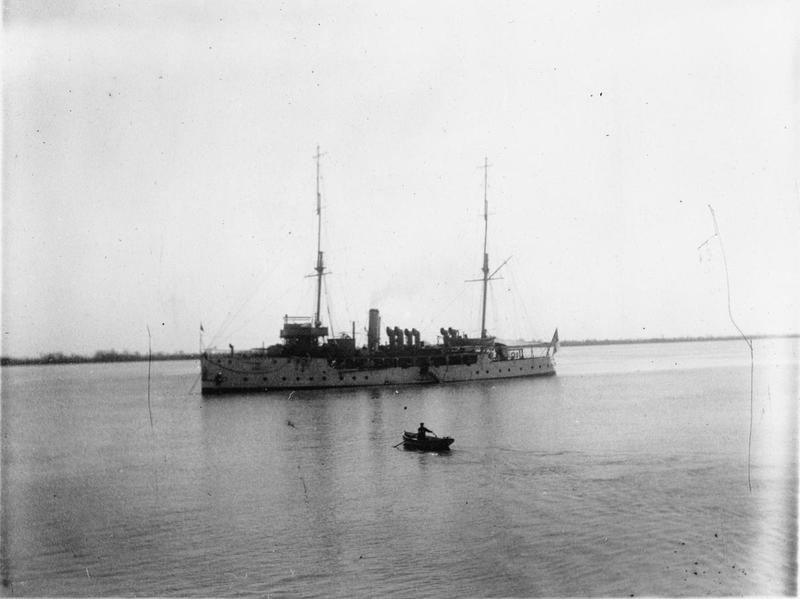
HMS Dwarf, Bramble, Britomart, Thistle
Design of the Bramble WW1 British Gunboats
The four all-steel Bramble-class gunboats were modern vessels with proper military reduced rigging, designed to protect far-flung outposts of the colonial empire. Still, with their lower tonnage than previous vessels, small dimensions at 180 feet long, 33 feet in beam, 8 feet draft (54.86 x 10.6 x 2.44) they were the smallest seagoing vessels built for the Royal Navy at that stage and the cheapest at £50,000 each. To give an idea this was 5% of what a pre-dreadnought cost at the time. These small dimensions and shallow draught facilitated navigation on all coastlines and great rivers around the world. But these dimensions also curtailed the storage to just 50 tons of coal. Thistle on trials, the best seagoing vessel of the class, could only run for 2.5 days at 11.5 knots. She was not a very good walker as a full-speed run burnt twice more coal. captains overruled design specs and found wherever possible additional storage, allowing to carry 145 tons of coal, good enough for a week at sea.
These gunboats still had a rigging though, albeit much reduced compared to the older barquentines. This small sailing to supplement their engines was a necessity for long-range cruises where coaling stations were rare. It was common among gunboats of the time and many cruisers. Being two-masted ships they used a “reduced” fore-and-aft sailplan close to colonial cruisers such as the Astrea and Eclipse class retaining military masts used for signal halyards and use their lookout positions and fighting tops, but allowing an emergency auxiliary rigging. Their originally design sailplan was either one of a brig or reduced brigantine.
Both making them less dependent of infrastructures and cheaper, the new WW1 British Gunboats were given all-steel hull but also a copper sheathing useful in tropical waters and minimal machinery, a triple-expansion steam engine procuring them a top speed of 13.5 knots, which at the time was just below battleships and cruisers. They used manual capstan for the anchors, traditional ship’s wheel for the rudder. Lighting was done also with candles as there was no electrical power on board. One of her boat had a small steam engine, the remainder three were rowed. These were a 27′ whaler, a 25′ cutter, a 16′ skiff or dinghy and the sole 23′ steam cutter.
However their armament combining four modern 4-inch guns, and four 12-pounders plus 0.5 (13 mm) Maxim heavy machine guns procured the firepower needed and comparable to other navies’s gunboats at the time.
The layout of these WW1 British Gunboats was modern compared to previous vessels, like small protected cruisers: They had a straight stem, high forecastle, a taller charthouse and long low deckhouse plus lower quarterdeck. They looked military and could not be confused with any windjammer/Yacht looking older barquentine gunboats. Internally they adopted the level or protection seen in protected cruisers with coal bunkers acting as an armour layer when stored around vital spaces. The decks themselves however were not protected and there was no belt. Crew cabins were generously wood-panelled and there was air-conditioning and an icemaker to deal with the effect of having a metallic hull under tropical sun.
The design proved successful enough to be copied outright by the Japanese. They modelled two gunboats which differed only in detail and between themselves, IJN Uji (1903) and Saga (1912).
Construction
Two were laid down at W.H. Potter & Sons, Liverpool, on 1 December 1897, the other pair a day after at London & Glasgow, Govan. Liverpool ships were HMS Bramble (launched 26 November 1898) and HMS Britomart (launched 29 March 1899) and Glasgow vessels were HMS Dwarf (launched 15 November 1898) and HMS Thistle (launched 22 June 1899). Logs of all four vessels can be found online at http://www.naval-history.net/
Service of the Bramble class WW1 British Gunboats
When they entered entered service, some in the Royal Navy vehemently ruled against the use of sail, and also gunboats in general. Sails were packed inside a storage area in the hull and later eliminated altogether, as well as rigging and spars. In WW1 all four ships showed their immobile lower masts and sometimes fore topmast kept only to support a radio antenna.
This steam-only choice forbade long-range deployment and the ship moved only with large extra coal reserves heaped on their open decks. This was bad enough HMS Thistle reverted to sail in 1919, with the simplified arrangement of a ketch and cutter.
In the 1920s, they were re-armed, exchanging their 12-pdr and venerable Maxim MGs for an a modern pair of Vickers 3-pdr (47 mm) and two 2-pdr (40 mm) pom-poms AA plus four Hotchkiss 3-pdr used as saluting guns and possibly dismounted for raiding parties.
Individual career
HMS Dwarf :
First to enter service, she was commissioned on 31 August 1899 and spent her active career patrolling along the western and southern coasts of Africa, from Gibraltar to the Limpopo River in East Africa, Indian Ocean (south Mozambique). She participated in the Boer War (1899–1902) and found herself the first British ship equipped with radio. In 1914, she decisively acted in the Allied naval campaign against German West Africa. She defeated notably the armed steamer Nachtigal in a gunnery duel. Later during the war, HMS Dwarf stayed largely in reserve at Gibraltar, recommissioned on demand. Paid off around 1925 she was sold in 1926.
HMS Bramble:
Both HMS Bramble and Britomart were commissioned on 28 June 1900, and sent to operate together from the China Station. They patrolled the Yangtse and the coast until 1906 and apparently, until 1915, saw limited periods at sea and reduced service. Back in full commission in late 1915 they were affected to the Indian Ocean Station, later alternating between the Persian Gulf (Mesopotamian campaign) and refit stops in Bombay.
HMS Bramble was paid off on 5 October 1919, sold in 1920. Britomart remained longer in service, and was sold on to a civilian owner on 6 October 1920, modified as merchant ship. She became in 1925, Shakuntala and probably scrapped in 1926.
HMS Thistle
She probably had the richest and most colorful career of the class: She served in West Africa but allo in Asia, on the Yangtze’s China station. In Nigeria, her crew brought in and introduced football. In China, she contained unrest in Hankou before the 1912 Revolution. In August 1914 she stayed in her China station, but in 1915, she was re-affected to the Indian Ocean for the East Africa Campaign, but she arrived too late. SMS Königsberg had been sunk. Nevertheless, she covered amphibious landings on the German East Africa coast and defended the Portuguese Mozambique. She was likely used in support of the Mesopotamian campaign afterwards, and in 1919, she crossed the Cape of Good Hope with a new sailing rig. Her machinery were repaired, but the sails were maintained. Decommissioned in 1925, with the distinction of being the last active sailing warship of the Royal Navy (not a museum ship like HMS Victory).
Specifications of the Bramble WW1 British Gunboats
Displacement: 710 tons standard, circa 800 Fully Loaded
Dimensions: Length 180 ft (55 m), Beam 33 ft (10 m), Draught 8 ft (2.4 m)
Powerplant: Two shafts prop, triple-expansion steam engine, 1,300 ihp (970 kW), 13.5 kn (25.0 km/h)
Range: 2,000-2,050 nm at 10.85-11.5 kn
Crew: 85
Armament: Two 4-inch, four 12pdr QF, four 0.45 in Maxim HMG
Insect class river gunboats (1915)
Aphis, Bee, Cicala, Cockchafer, Cricket, Glowworm, Gnat, Ladybird, Mantis, Moth, Suma, Scarab, Tarantula.
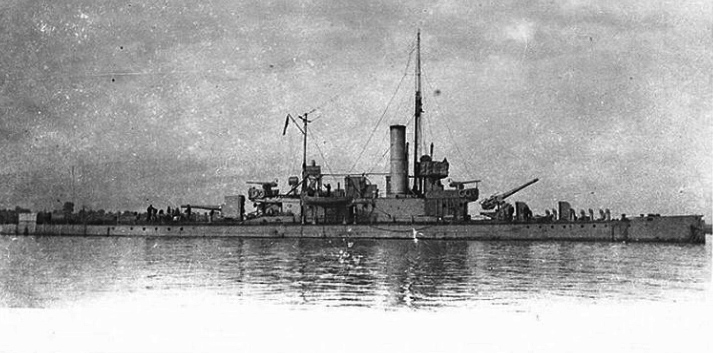
These riverine ships were very different from the earlier Bramble class. At the time, soon after the war broke out, gunboats seemed a distant memory and had its detractors within the Royal Navy. But at the same time ships were needed to fill particular purposes when the Navy was concentrating on defeating the Germans. In reality they had been built to help the war effort on the Danube, but to conceal their true role, they were officially called “Large China Gunboats”. Their true objective was to destroy the powerful Austro-Hungarian riverine flotilla in order to help the Russian efforts and prevent the Austro-Hungarians using the Danube for bringing reinforcements and supplies.
They were designed by Yarrow to operate in shallow, fast-flowing rivers and had a shallow draught, good agility and enough power to sail upstream. For this, they were fitted with two reciprocating (VTE) engines connected on two propeller shafts contrary to most past gunboats, for redundancy. They were housed in tunnels, in order to minimise draught as well. Main armament was considerable, greater than any past gunboat in the Royal Navy, consisting in two 6 inch guns installed fore and aft. The general concept was sound enough that they stayed in service in the interwar and saw action in WW2 as well.
Design of the Insect class gunboats
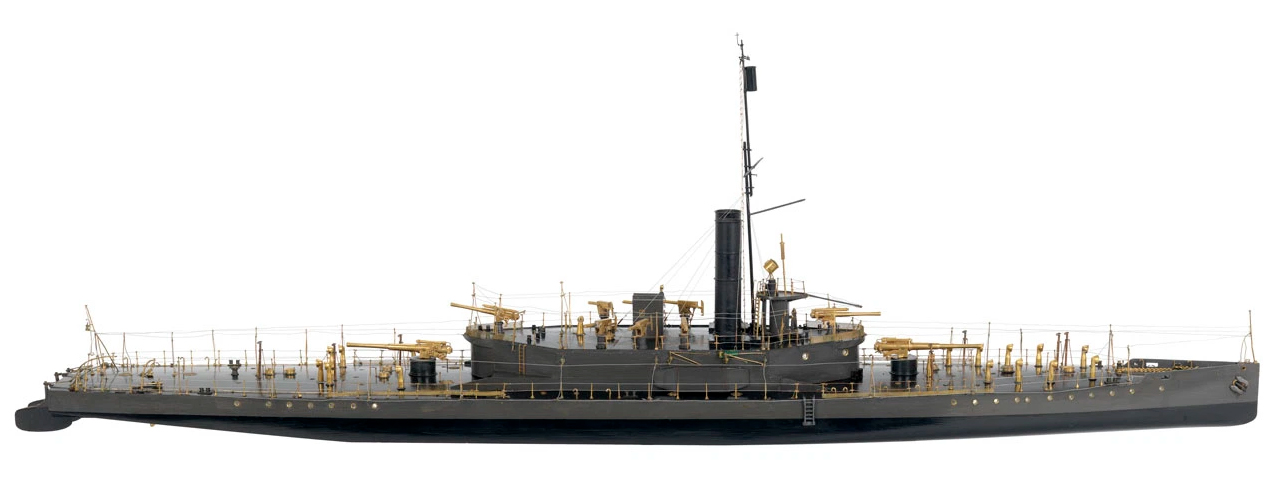
A builder’s model of HMS Cockchafer at Greenwhich museum (Coll. photo)
Ordered in February 1915 these WW1 British Gunboats were built quickly, designed in effect as miniature monitors, with a solid armament that could have been largely enough indeed to deal with the Austro-Hungarian riverine monitors. They had a favourable ratio for speed, as under 625 long tons displacement they measured 237 ft 6 in overall (72.39 m) for 36 ft (11 m) in beam, so roughly 1/7. Riverine action was helped by a draught of just 4 ft (1.2 m), there was just a limited “belly” so all the weight above the waterline needed to be put lower to keep so the center of gravity. Superstructures were kept minimal, light and unarmoured. The other interesting point were its divided powerplant, with twice the exact system, both separated by a bulkhead. One shaft was mated on a single VTE engine, fed by its own mixed firing boiler, for 2000 IHP in total. The mixed firing helped to find supplies all around the world. Each powerplant had its own funnel, so these ships showed that old school configuration of tandem funnels. The top speed of 14 knots (16 mph; 26 km/h) was sufficient for riverine operations, which imposed a more cautious navigation. It was superior to some old unprotected cruisers and most gunboats of the time either. Two generous rudders at the stern, with a manual backup gave a good agility and although the ship had no counterkeels, the hull lines were fine and well made, both for speed and stability and the prow had a raised breakwater.
The superstructure of these WW1 British Gunboats was concentrated in the center portion, about 1/3 of the total length, and prismatic to provide the best arc of fire for both main guns. The command post was a simple platform placed over a tube, supporting a small platform in open air with a ship’s telegraph and projector for night operations. Light artillery was installed on this superstructure’s roof: Two 12-pdr (3 inches/76 mm) fore and aft, and six Maxim heavy machine guns amidship, on six pivot mounts behind the twin funnels and abreast the radio room.
There were variations in armament though: If the 6-inch Mk VII guns and 12-pounder guns were reliable QF guns, the .303 machine guns were already obsolete in 1915, and a single QF 2-pounder “Pom-Pom” was often install, or a single QF 3-inch anti-aircraft gun in place of the former 12-pdr. In 1916-17, Cicala, Cockchafer, Cricket, Glowworm had their 6-in Mk II/CP II placed on new AA mounts with 53° elevation for use against Zeppelins. During the interwar, a .303″ Lewis machine guns were added on pivots, or even an Oerlikon 20 mm cannon during WW2 for those still in service.
The armour official figures, if any, are unknown; Nothing is shown to that matter, and it seemed it was left to captains to proceed on site depending of the circumstance to protect their ships.
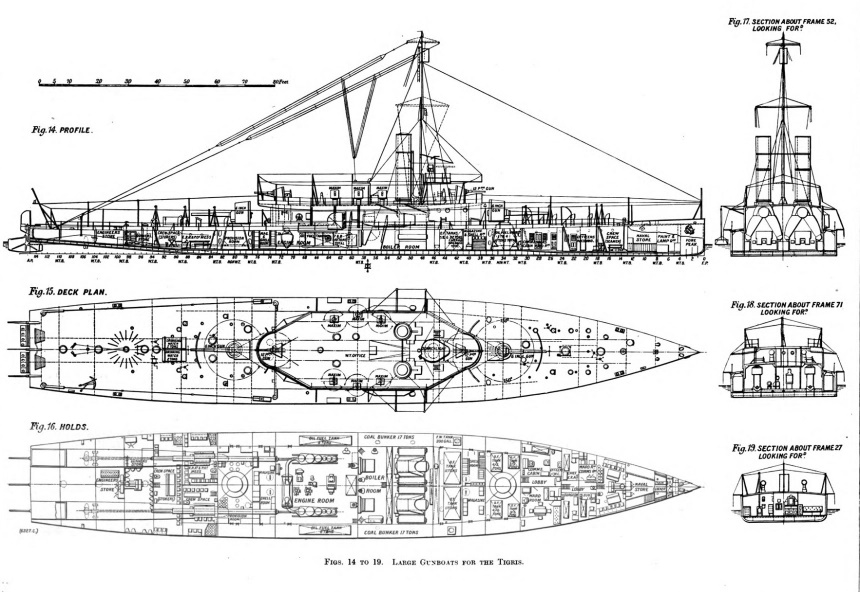
HMS Cockchafer, cutaway of the class. See another of their interwar/WW2 service in Asia as rebuilt
Specifications of the Insect class WW1 British Gunboats
Displacement: 625 long tons standard
Dimensions: 237.5 x 36 x 4 ft (72.4x 11 x 1.2 m)
Propulsion: 2 shaft VTE, 2 Yarrow mixed boilers, 2000 IHP, 14 knots
Range: 35 tons coal + 54 tons oil: Circa 3000 nm.
Complement: 54-65
Armament: Two 6-in, Two QF 3-in, Six .303-cal Maxim MG
WW2 armament: Two QF 6 in/40 naval guns, two 76/45 Mk II, two 40/39 Mk VIII
The Insect class in service
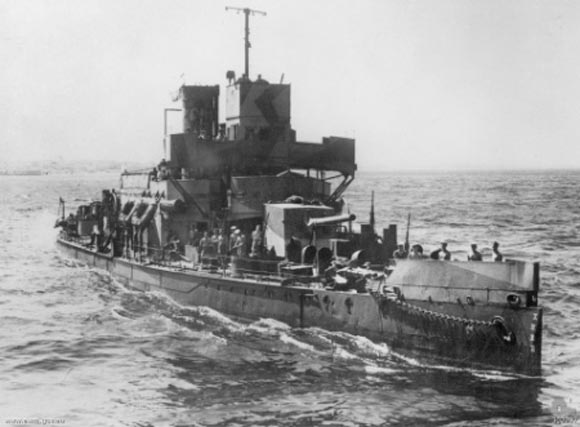
HMS Aphis
Operations on the Danube were cancelled when the ship were completed: Resistance there simply collapsed. Instead, the bulk of the ships served in the middle east. HMS Aphis, Bee, Ladybird and Scarab were therefore deployed in Port Said (Egypt) from 1915 to 1916, while HMS Gnat, Mantis, Moth and Tarantula were affected to the Persian Gulf in 1916. HMS Glowworm, Cicala, Cockchafer and Cricket went to home waters, on the east coast by 1916 with the main purpose of defeating Zeppelins during their approach at Brightlingsea and Lowestoft.
In September 1918, the same vessels were sent to north Russia, in order to enter the Dvina and participate to the action there. Gloworm became a total constructive loss after a barge exploded on her flank, in August 1929. Cicala, Cockchafer, Cricket, were joined later by Moth and Mantis, and went on soldiering on the Dvina River especially in in Arkhangelsk Oblast, in support of White Russian forces. The crew of Cicala mutinied and five “ringleaders” were sentenced to death. Meanwhile in 1918, Aphis and Ladybird eventually patrolled the Danube until 1922 to prevent “red” incursions, Bee and Scarab were sent to Hog Kong and later Gnat, Tarantula, Cicala, Cockchafer, Cricket, Mantis and Moth, towed out from UK in 1920.
Interwar:
Between the two world wars, all the class were used in the Far East and saw the Japanese invasion of China. In 1937 HMS Ladybird was on the Yangtze river when she was fired upon from an IJA shore battery while USS Panay was sunk by aviation nearby. Ladybird went on 20 miles an rescued some of the Panay survivors, brought later to Shanghai. Scarab and Cricket were off Nanking in 1937 but were not harmed. In 1939, they went through reconstructions. Their old 6 inch Mk VII 45-calibre guns (Aphis and Ladybird) were replaced by the longer 6-inch Mk XIII 50-cal. from Agincourt, decommissioned. Their superstructures were improved and they obtained a true enclose bridge.
WW2:
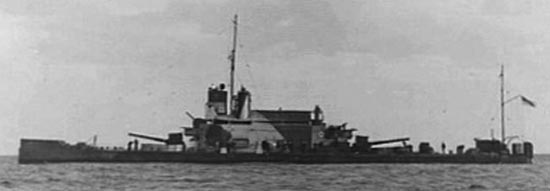
HMS Ladybird off Bardia in 1940 (AWM)
At the start of World War II, HMS Cricket, Gnat, and Ladybird were transferred to the Mediterranean theater, with the Inshore Squadron, alongside the monitor Terror, providing bombardment in support for the 8th Army but also as supply and landing vessels, closing-in to beaches. In June 1943, HMS Aphis, already in Malta in 1920 with Ladybird, participated in the shelling of Pantelleria (Operation Corkscrew). Cricket was bombed by axis aviation on 29 june 1941, but survived. Laid up in port said and stripped from her armament she was stricken and BU in 1942. Gnat was torpedoed by U79 on 21 October 1941, laid up in Suez, BU 1945. Ladybird was sunk by aviation off Tobruk.
In Hong Kong on 12 December 1941, HMS Cicala was sunk by the IJN aviation, while Moth was scuttled. Raised by the Japanese, she became IJN Suma. She hit a mine on the Yangtse on 19 March 1945 and sank. Tarantula and the rest of the asiatic vessels were in Trincomanlee, and the former was sank as target while the remainder, Aphis, Cockchafer and Scarab were sold for BU in 1947-49.
Fly class river gunboats (1915)
Blackfly, Butterfly, Caddisfly, Cranefly, Dragonfly, Firefly, Gadfly, Grayfly, Greenfly, Hoverfly, Mayfly, Sawfly, Sedgefly, Snakefly, Stonefly, Waterfly
Also known as the “Tigris gunboat flotilla”, these small, but well-armed riverine gunboats were initially designed to patrol the Tigris river, during the Mesopotamian Campaign.
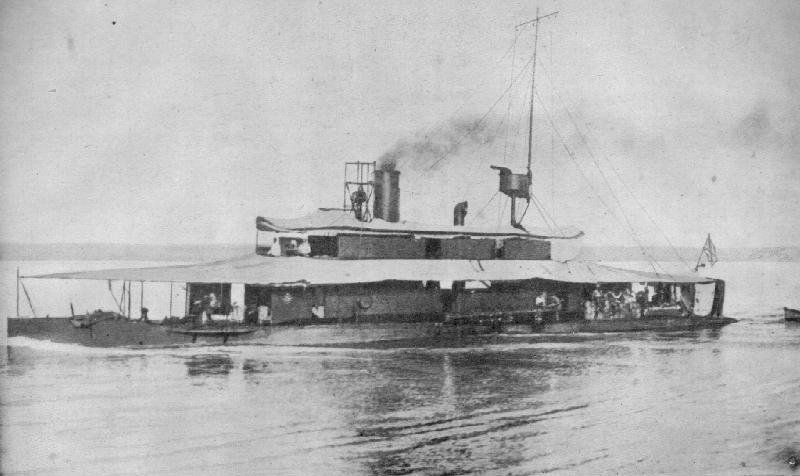
HMS Firefly on the Tigris river
Design of these WW1 British light Riverine Gunboats:
They were fitted with a single triple expansion steam engine, driving a propeller in tunnel like the Insect class to keep a very shallow profile: Draught was just 2 foot (60 cm). They were also designed in sections in order to be transported by rail or ship with ease and re-assembled on site, in standard crates so not to draw attention. Labelled “top secret” indeed they were built by Yarrow Shipbuilders, Scotstoun (Glasgow) in 1915-1916. Contrary to the far larger Insect class, they lacked redundancy with their sole engine, single boiler, and their top speed was quite slow, range reduced to their operative area. The armament was very diverse, comprising a single one of each caliber or so: Single 4-inch (102-mm) gun on the deck forward, single 12-pounder (76-mm) gun on the deck aft, single 6-pounder (57-mm) gun for some on the superstructure or in place of the 3-in, single 3-pounder (47-mm) and single 2-pounder (40-mm) pom-pom AA, plus four of five machine guns.
The ‘Fly’ WW1 British Gunboats in service:
The ‘Fly’ class was shipped out to Abadan and assembled there. They patrolled the Tigris River under Navy command, until transfer to the Army in 1918, and perform transport and artillery support tasks during the final phase of the campaign. But since they lacked the range to be useful elsewhere, they had no more use after the war, and were sold off circa 1923.
HMS Firefly was the only one which career was rocky enough of notice: She was captured by the Ottoman Army in December 1915 after she ran aground. Indeed she was hit by artillery and a shell penetrated and disabled her boiler. Dead in the water, she was evacuated. Under the Turkish flag, she was pressed into service as Suleiman Pak, but was later recaptured by HMS Tarantula during the Battle of Nahr-al-Kalek on 26 February 1917 and returned into British service until the end of the war.
Specifications of the Fly class WW1 British Gunboats
Dimensions: 126 x 20 x 2 ft (38 x 6.1 x 0.61 m)
Propulsion: 1 shaft VTE, yarrow mixed firing boiler, 175 ihp (130 kW)
Top Speed: 9.5 knots (10.9 mph; 17.6 km/h)
Range: Unknown (circa 1000 nm)
Complement: 22
Armament: 4-in, 12 pdr, 3 pdr, 2 pdr, 4 MGs


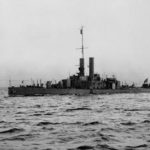
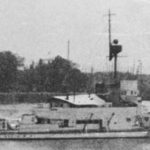
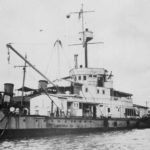
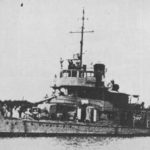
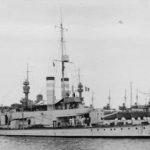
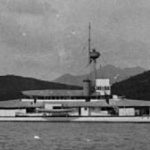
 Latest Facebook Entry -
Latest Facebook Entry -  X(Tweeter) Naval Encyclopedia's deck archive
X(Tweeter) Naval Encyclopedia's deck archive Instagram (@navalencyc)
Instagram (@navalencyc)





 French Navy
French Navy Royal Navy
Royal Navy Russian Navy
Russian Navy Armada Espanola
Armada Espanola Austrian Navy
Austrian Navy K.u.K. Kriegsmarine
K.u.K. Kriegsmarine Dansk Marine
Dansk Marine Nautiko Hellenon
Nautiko Hellenon Koninklije Marine 1870
Koninklije Marine 1870 Marinha do Brasil
Marinha do Brasil Osmanlı Donanması
Osmanlı Donanması Marina Do Peru
Marina Do Peru Marinha do Portugal
Marinha do Portugal Regia Marina 1870
Regia Marina 1870 Nihhon Kaigun 1870
Nihhon Kaigun 1870 Preußische Marine 1870
Preußische Marine 1870 Russkiy Flot 1870
Russkiy Flot 1870 Svenska marinen
Svenska marinen Søværnet
Søværnet Union Navy
Union Navy Confederate Navy
Confederate Navy Armada de Argentina
Armada de Argentina Imperial Chinese Navy
Imperial Chinese Navy Marinha do Portugal
Marinha do Portugal Mexico
Mexico Kaiserliche Marine
Kaiserliche Marine 1898 US Navy
1898 US Navy Sovietskiy Flot
Sovietskiy Flot Royal Canadian Navy
Royal Canadian Navy Royal Australian Navy
Royal Australian Navy RNZN Fleet
RNZN Fleet Chinese Navy 1937
Chinese Navy 1937 Kriegsmarine
Kriegsmarine Chilean Navy
Chilean Navy Danish Navy
Danish Navy Finnish Navy
Finnish Navy Hellenic Navy
Hellenic Navy Polish Navy
Polish Navy Romanian Navy
Romanian Navy Turkish Navy
Turkish Navy Royal Yugoslav Navy
Royal Yugoslav Navy Royal Thai Navy
Royal Thai Navy Minor Navies
Minor Navies Albania
Albania Austria
Austria Belgium
Belgium Columbia
Columbia Costa Rica
Costa Rica Cuba
Cuba Czechoslovakia
Czechoslovakia Dominican Republic
Dominican Republic Haiti
Haiti Hungary
Hungary Honduras
Honduras Estonia
Estonia Iceland
Iceland Eire
Eire Equador
Equador Iran
Iran Iraq
Iraq Latvia
Latvia Liberia
Liberia Lithuania
Lithuania Mandchukuo
Mandchukuo Morocco
Morocco Nicaragua
Nicaragua Persia
Persia San Salvador
San Salvador Sarawak
Sarawak Uruguay
Uruguay Venezuela
Venezuela Zanzibar
Zanzibar Warsaw Pact Navies
Warsaw Pact Navies Bulgaria
Bulgaria Hungary
Hungary

 Bundesmarine
Bundesmarine Dutch Navy
Dutch Navy Hellenic Navy
Hellenic Navy Marina Militare
Marina Militare Yugoslav Navy
Yugoslav Navy Chinese Navy
Chinese Navy Indian Navy
Indian Navy Indonesian Navy
Indonesian Navy JMSDF
JMSDF North Korean Navy
North Korean Navy Pakistani Navy
Pakistani Navy Philippines Navy
Philippines Navy ROKN
ROKN Rep. of Singapore Navy
Rep. of Singapore Navy Taiwanese Navy
Taiwanese Navy IDF Navy
IDF Navy Saudi Navy
Saudi Navy Royal New Zealand Navy
Royal New Zealand Navy Egyptian Navy
Egyptian Navy South African Navy
South African Navy






























 Ukrainian Navy
Ukrainian Navy dbodesign
dbodesign